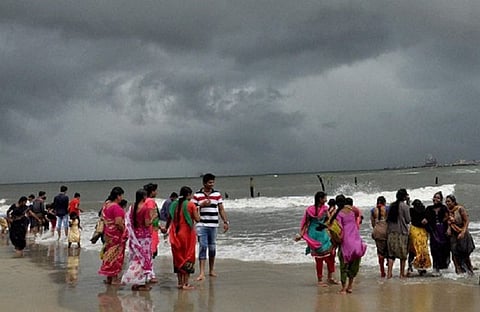

This time last year, Chennai was bracing itself for the floods. Heavy spells of rainfall across the coastal districts left parts of Tamil Nadu reeling from the Northeast monsoon. A year later, Tamil Nadu may have to prepare itself for a parched summer as the monsoon continues to remain weak through mid-November.
While the onset of the NE monsoon was delayed, arriving on October 30, the Indian Meteorological Department had predicted a below normal to normal monsoon this year. Two weeks into November, there is widespread concern that it will be a deficient year, as the rains continue to keep away. S Balachandran, Director, Area Cyclone Warning Centre told TNM that there has been a rain deficit of 66% in Tamil Nadu.
So, why has there been a lull in the Northeast monsoon this year?
“There is no weather producing system and for there to be a system there has to be a formation near the Andaman Sea or south Bay of Bengal. The background flow is weak and the moisture content is weak,” explains Balachandran.
Weather blogger K Srikanth, who blogs at Chennaiyil Oru Mazhaikkaalam, points out that two systems – the Kyant Cyclone and another depression which moved towards Bangladesh impacted the rainfall and wind patterns. The late onset of the monsoon, he says, is on account of Cyclone Kyant.
Another explanation, he reasons, “The overall atmosphere is suppressed in the Indian Ocean. Warm tropical waves (MJO) influence and trigger rains and cyclones. There have been no such triggers. That’s why you are seeing dry climate, there is very little moisture.”
Should Chennai prepare for a drought?
While coastal Tamil Nadu gets 60% of its annual rainfall during the NE monsoon season, interior parts of the state receive 40 to 50% of rainfall during the months of October to December. Moreover, November is considered peak monsoon season, when the state receives the maximum amount of rainfall.
According to the weather blog, Chennai is presently staring at a deficit of 81%. Other coastal districts are no better off. Cuddalore has a rain deficit of 77%, Kanchipuram 87% and Villupuram 66% among other districts.
“Just like officials are prepared for the floods this year, there should be a plan put in place for water conservation. It should start early as we move into December and January. Mettur is already in bad shape, the lake levels in Chennai are presently at 10% of its storage capacity,” argues Srikanth. To compensate for the rain deficit, Chennai would need to receive 14.9mm every day, or more than double the amount it has received so far.
He, however, adds that Chennai, to a certain extent, received good rains during the off-season and from the Southwest monsoon, mitigating the possibility of a poor Northeast monsoon.
There could also be rain clouds in store for the city towards the end of November. The weather blogger says that models indicate cyclonic activity from November 23 to November 29. Moreover, peak rainfall may occur between November 25 to December 10. “We need systems to be active in the Bay of Bengal, otherwise it won’t help,” he states.
Balachandran points out, “There have been phases of a monsoon lull in the past as well. It all depends on the strength of the background flow.”
Srikanth, however, predicts that the monsoon will be more active in southern and interior Tamil Nadu. “Currently, there is a disturbance in Andaman Sea, which is travelling westerly. It is heading towards Sri Lanka, possibly surfacing in the Arabian Sea. The indication is that delta and south Tamil Nadu would get normal rain,” he observes.